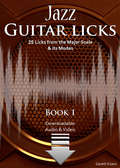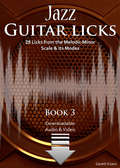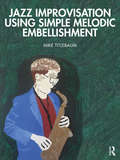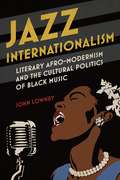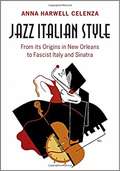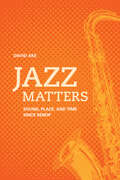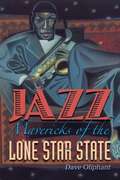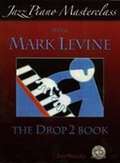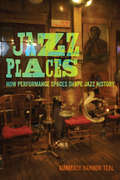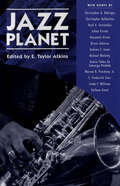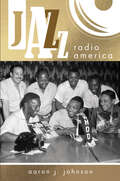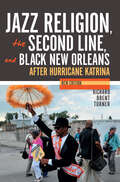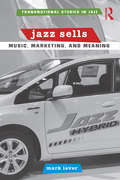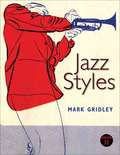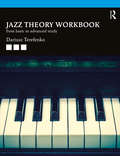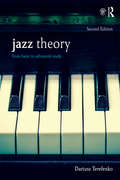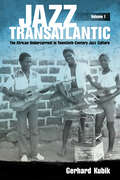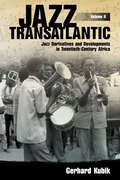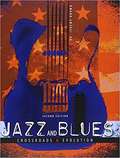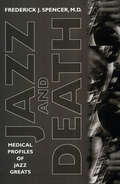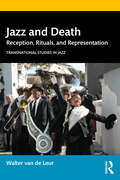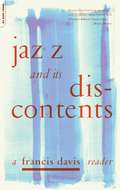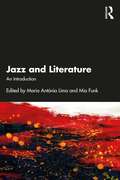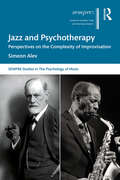- Table View
- List View
Jazz Guitar Licks: 25 Licks from the Major Scale & its Modes with Audio & Video (Jazz Guitar Licks #1)
by Gareth Evans25 original jazz guitar licks from the Major scale and its modes in tablature and notation. >> 117 bars of music over 25 licks (average lick length 4.68 bars) >> Video at full speed & Audio at full & half speed (Downloadable) >> Backing tracks at full and slower practise speeds (Downloadable) >> Scale diagrams with theory and technique tips for each lick >> Guitar tablature has picking directions & fretting finger guide numbers Please Note: This eBook has written music and is not suitable for smaller screens.
Jazz Guitar Licks: 25 Licks from the Melodic Minor Scale & its Modes with Audio & Video (Jazz Guitar Licks #3)
by Gareth Evans25 original jazz guitar licks from the Melodic minor scale and its modes in tablature and notation. >> 118 bars of music over 25 licks (average lick length 4.72 bars) >> Video at full speed & Audio at full & half speed (Downloadable) >> Backing tracks at full and slower practise speeds (Downloadable) >> Scale diagrams with theory and technique tips for each lick >> Guitar tablature has picking directions & fretting finger guide numbers Please Note: This eBook has written music and is not suitable for smaller screens.
Jazz Improvisation Using Simple Melodic Embellishment
by Mike TitlebaumJazz Improvisation Using Simple Melodic Embellishment teaches fundamental concepts of jazz improvisation, highlighting the development of performance skills through embellishment techniques. Written with the college-level course in mind, this introductory textbook is both practical and comprehensive, ideal for the aspiring improviser, focused not on scales and chords but melodic embellishment. It assumes some basic theoretical knowledge and level of musicianship while introducing multiple techniques, mindful that improvisation is a learned skill as dependent on hard work and organized practice as it is on innate talent. This jargon-free textbook can be used in both self-guided study and as a course book, fortified by an array of interactive exercises and activities: musical examples performance exercises written assignments practice grids resources for advanced study and more! Nearly all musical exercises—presented throughout the text in concert pitch and transposed in the appendices for E-flat, B-flat, and bass clef instruments—are accompanied by backing audio tracks, available for download via the Routledge catalog page along with supplemental instructor resources such as a sample syllabus, PDFs of common transpositions, and tutorials for gear set-ups. With music-making at its core, Jazz Improvisation Using Simple Melodic Embellishment implores readers to grab their instruments and play, providing musicians with the simple melodic tools they need to "jazz it up."
Jazz Internationalism: Literary Afro-Modernism and the Cultural Politics of Black Music
by John LowneyJazz Internationalism offers a bold reconsideration of jazz's influence in Afro-modernist literature. Ranging from the New Negro Renaissance through the social movements of the 1960s, John Lowney articulates nothing less than a new history of Afro-modernist jazz writing. Jazz added immeasurably to the vocabulary for discussing radical internationalism and black modernism in leftist African American literature. Lowney examines how Claude McKay, Ann Petry, Langston Hughes, and many other writers employed jazz as both a critical social discourse and mode of artistic expression to explore the possibilities ”and challenges ”of black internationalism. The result is an expansive understanding of jazz writing sure to spur new debates.
Jazz Italian Style: From its Origins in New Orleans to Fascist Italy and Sinatra
by Anna Harwell Celenza<p>Jazz Italian Style explores a complex era in music history, when politics and popular culture collided with national identity and technology. When jazz arrived in Italy at the conclusion of World War I, it quickly became part of the local music culture. In Italy, thanks to the gramophone and radio, many Italian listeners paid little attention to a performer's national and ethnic identity. Nick LaRocca (Italian-American), Gorni Kramer (Italian), the Trio Lescano (Jewish-Dutch), and Louis Armstrong (African-American), to name a few, all found equal footing in the Italian soundscape. <p>The book reveals how Italians made jazz their own, and how, by the mid-1930s, a genre of jazz distinguishable from American varieties and supported by Mussolini began to flourish in Northern Italy and in its turn influenced Italian-American musicians. Most importantly, the book recovers a lost repertoire and an array of musicians whose stories and performances are compelling and well worth remembering.
Jazz Matters: Sound, Place, and Time since Bebop
by David AkeWhat, where, and when is jazz? To most of us jazz means small combos, made up mostly of men, performing improvisationally in urban club venues. But jazz has been through many changes in the decades since World War II, emerging in unexpected places and incorporating a wide range of new styles. In this engrossing new book, David Ake expands on the discussion he began in Jazz Cultures, lending his engaging, thoughtful, and stimulating perspective to post-1940s jazz. Ake investigates such issues as improvisational analysis, pedagogy, American exceptionalism, and sense of place in jazz. He uses provocative case studies to illustrate how some of the values ascribed to the postwar jazz culture are reflected in and fundamentally shaped by aspects of sound, location, and time.
Jazz Mavericks of the Lone Star State
by Dave OliphantJazz is one of America's greatest gifts to the arts, and native Texas musicians have played a major role in the development of jazz from its birth in ragtime, blues, and boogie-woogie to its most contemporary manifestation in free jazz. Dave Oliphant began the fascinating story of Texans and jazz in his acclaimed book Texan Jazz, published in 1996. Continuing his riff on this intriguing musical theme, Oliphant uncovers in this new volume more of the prolific connections between Texas musicians and jazz. Jazz Mavericks of the Lone Star State presents sixteen published and previously unpublished essays on Texans and jazz. Oliphant celebrates the contributions of such vital figures as Eddie Durham, Kenny Dorham, Leo Wright, and Ornette Coleman. He also takes a fuller look at Western Swing through Milton Brown and his Musical Brownies and a review of Duncan McLean's Lone Star Swing. In addition, he traces the relationship between British jazz criticism and Texas jazz and defends the reputation of Texas folklorist Alan Lomax as the first biographer of legendary jazz pianist-composer Jelly Roll Morton. In other essays, Oliphant examines the links between jazz and literature, including fiction and poetry by Texas writers, and reveals the seemingly unlikely connection between Texas and Wisconsin in jazz annals. All the essays in this book underscore the important parts played by Texas musicians in jazz history and the significance of Texas to jazz, as also demonstrated by Oliphant's reviews of the Ken Burns PBS series on jazz and Alfred Appel Jr. 's Jazz Modernism.
Jazz Piano Masterclass with Mark Levine: The Drop 2 Book
by Mark LevineThis book covers both the basic version of the jazz technique called drop 2 and the more advanced version.
Jazz Places: How Performance Spaces Shape Jazz History
by Kimberly Hannon TealThe social connotation of jazz in American popular culture has shifted dramatically since its emergence in the early twentieth century. Once considered youthful and even rebellious, jazz music is now a firmly established American artistic tradition. As jazz in American life has shifted, so too has the kind of venue in which it is performed. In Jazz Places, Kimberly Hannon Teal traces the history of jazz performance from private jazz clubs to public, high-art venues often associated with charitable institutions. As live jazz performance has become more closely tied to nonprofit institutions, the music's heritage has become increasingly important, serving as a means of defining jazz as a social good worthy of charitable support. Though different jazz spaces present jazz and its heritage in various and sometimes conflicting terms, ties between the music and the past play an important role in defining the value of present-day music in a diverse range of jazz venues, from the Village Vanguard in New York to SFJazz on the West Coast to Preservation Hall in New Orleans.
Jazz Planet
by E. Taylor AtkinsWith contributions by Raúl A. Fernández, Benjamin Givan, Acácio Tadeu de Camargo Piedade, Warren R. Pinckney Jr., Linda F. Williams, Christopher G. Bakriges, Stefano Zenni, S. Frederick Starr, Bruce Johnson, Christophine Ballantine, Michael Molasky, Johan Fornäs, and Andrew F. JonesJazz is typically characterized as a uniquely American form of artistic expression, and narratives of its history are almost always set within the United States. Yet, from its inception, this art form exploded beyond national borders, becoming one of the first modern examples of a global music sensation. Jazz Planet collects essays that concentrate for the first time on jazz created outside the United States. What happened when this phenomenon met with indigenous musical practices? What debates on cultural integrity did this “American” styling provoke in far-flung places? Did jazz's insistence on individual innovation and its posture as a music of the disadvantaged generate shakeups in national identity, aesthetic values, and public morality? Through new and previously published essays, Jazz Planet recounts the music's fascinating journeys to Asia, Europe, Africa, and Latin America. What emerges is a concept of jazz as a harbinger of current globalization, a process that has engendered both hope for a more enlightened and tranquil future and resistance to the anticipated loss of national identity and sovereignty. Essays in this collection describe the seldom-acknowledged contributions non-Americans have made to the art and explore the social and ideological crises jazz initiated around the globe. Was the rise of jazz in global prominence, they ask, simply a result of its inherent charm? Was it a vehicle for colonialism, Cold War politics, and emerging American hegemony? Jazz Planet provokes readers to question the nationalistic bias of most jazz scholarship, and to expand the pantheon of great jazz artists to include innovative musicians who blazed independent paths.
Jazz Radio America (Music in American Life)
by Aaron J. JohnsonOnce a lively presence on radio, jazz now finds itself relegated to satellite broadcasters and low-watt stations at the edge of the dial. Aaron J. Johnson examines jazz radio from the advent of Black radio in 1948 to its near extinction from the commercial dial after 1980. Even in jazz’s heyday, programmers and DJs excluded many styles and artists, and Johnson delves into how the politics of decision-making and the political uses of the medium shaped jazz radio formats. Johnson shows radio’s role in the contradictory perceptions of jazz as American’s model artistic contribution to the world, as Black classical music, and as the soundtrack of African American rebellion and resistance for much of the twentieth century. An interwoven story of a music and a medium, Jazz Radio America answers perennial questions about why certain kinds of jazz get played and why even that music is played in so few places.
Jazz Religion, the Second Line, and Black New Orleans: After Hurricane Katrina
by Richard Brent TurnerThis scholarly study demonstrates “that while post-Hurricane Katrina New Orleans is changing, the vibrant traditions of jazz . . . must continue” (Journal of African American History).An examination of the musical, religious, and political landscape of black New Orleans before and after Hurricane Katrina, this revised edition looks at how these factors play out in a new millennium of global apartheid. Richard Brent Turner explores the history and contemporary significance of second lines—the group of dancers who follow the first procession of church and club members, brass bands, and grand marshals in black New Orleans’s jazz street parades.Here music and religion interplay, and Turner’s study reveals how these identities and traditions from Haiti and West and Central Africa are reinterpreted. He also describes how second line participants create their own social space and become proficient in the arts of political disguise, resistance, and performance.
Jazz Sells: Music, Marketing, and Meaning
by Mark LaverJazz Sells: Music, Marketing, and Meaning examines the issues of jazz, consumption, and capitalism through advertising. On television, on the Internet, in radio, and in print, advertising is a critically important medium for the mass dissemination of music and musical meaning. This book is a study of the use of the jazz genre as a musical signifier in promotional efforts, exploring how the relationship between brand, jazz music, and jazz discourses come together to create meaning for the product and the consumer. At the same time, it examines how jazz offers an invaluable lens through which to examine the complex and often contradictory culture of consumption upon which capitalism is predicated.
Jazz Styles: History and Analysis
by Mark C. GridleyThis book was written to help listeners increase their appreciation and enjoyment of jazz. The book and its accompanying Demo CD give readers a peek into how jazz musicians put together performances and how their methods have differed from style to style.
Jazz Theory Workbook: From Basic to Advanced Study
by Dariusz TerefenkoJazz Theory Workbook accompanies the second edition of the successful Jazz Theory—From Basic to Advanced Study textbook designed for undergraduate and graduate students studying jazz. The overall pedagogy bridges theory and practice, combining theory, aural skills, keyboard skills, and improvisation into a comprehensive whole. While the Companion Website for the textbook features aural and play-along exercises, along with some written exercises and the answer key, this workbook contains brand-new written exercises, as well as as well as four appendices: (1) Rhythmic Exercises, (2) Common-Practice Harmony at the Keyboard, (3) Jazz Harmony at the Keyboard, and (4) Patterns for Jazz Improvisaton. Jazz Theory Workbook works in tandem with its associated textbook in the same format as the 27-chapter book, yet is also designed to be used on its own, providing students and readers with quick access to all relevant exercises without the need to download or print pages that inevitably must be written out. The workbook is sold both on its own as well as discounted in a package with the textbook. Jazz Theory Workbook particularly serves the ever-increasing population of classical students interested in jazz theory or improvisation. This WORKBOOK is available for individual sale in various formats: Print Paperback: 9781138334250 Print Hardback: 9781138334243 eBook: 9780429445477 The paperback WORKBOOK is also paired with the corresponding paperback TEXTBOOK in a discounted PACKAGE (9780367321963).
Jazz Theory: From Basic to Advanced Study
by Dariusz TerefenkoJazz Theory: From Basic to Advanced Study, Second Edition, is a comprehensive textbook for those with no previous study in jazz, as well as those in advanced theory courses. Written with the goal to bridge theory and practice, it provides a strong theoretical foundation from music fundamentals to post-tonal theory, while integrating ear training, keyboard skills, and improvisation. It hosts "play-along" audio tracks on a Companion Website, including a workbook, ear-training exercises, and an audio compilation of the musical examples featured in the book. Jazz Theory is organized into three parts: Basics, Intermediate, and Advanced. This approach allows for success in a one-semester curriculum or with subsequent terms. If students sense that theory can facilitate their improvisational skills or can help them develop their ears, they become more engaged in the learning process. The overall pedagogical structure accomplishes precisely that in an original, creative—and above all, musical—manner. KEY FEATURES include 390 musical examples, ranging from original lead sheets of standard tunes, jazz instrumentals, transcriptions, and original compositions, to fully realized harmonic progressions, sample solos, and re-harmonized tunes. The completely revamped Companion Website hosts: 46 "Play Along Sessions" audio tracks, offering experiences close to real-time performance scenarios. Over 1,000 (audio and written) exercises covering ear training, rhythm, notation, analysis, improvisation, composition, functional keyboard, and others. Recordings of all 390 musical examples from the textbook. Links: Guide to Making Transcriptions, List of Solos to Transcribe, Selected Discography, Classification of Standard Tunes, and more. Lists of well-known standard tunes, including a comprehensive list of 999 Standard Tunes – Composers and Lyricists. NEW TO THE SECOND EDITION are instructors’ tools with answer keys to written and ear-training exercises, 380 rhythmic calisthenics featuring exercises from the swing, bebop, and Latin rhythmic traditions, a new improvisation section, a set of 140 Comprehensive Keyboard exercises, plus an expanded ear-training section with 125 melodic, 50 rhythmic dictations, and 170 harmonic dictations, plus 240 written exercises, 25 composition assignments, and 110 singing exercises.
Jazz Transatlantic, Volume I: The African Undercurrent in Twentieth-Century Jazz Culture (American Made Music Series)
by Gerhard KubikA CHOICE 2018 Outstanding Academic TitleIn Jazz Transatlantic, Volume I, renowned scholar Gerhard Kubik takes the reader across the Atlantic from Africa to the Americas and then back in pursuit of the music we call jazz. This first volume explores the term itself and how jazz has been defined and redefined. It also celebrates the phenomena of jazz performance and uncovers hidden gems of jazz history. The volume offers insights gathered during Kubik's extensive field work and based on in-depth interviews with jazz musicians around the Atlantic world. Languages, world views, beliefs, experiences, attitudes, and commodities all play a role. Kubik reveals what is most important--the expertise of individual musical innovators on both sides of the Atlantic, and hidden relationships in their thoughts.Besides the common African origins of much vocabulary and structure, all the expressions of jazz in Africa share transatlantic family relationships. Within that framework, musicians are creating and re-creating jazz in never-ending contacts and exchanges. The first of two volumes, Jazz Transatlantic, Volume I examines this transatlantic history, sociolinguistics, musicology, and the biographical study of personalities in jazz during the twentieth century. This volume traces the African and African American influences on the creation of the jazz sound and traces specific African traditions as they transform into American jazz. Kubik seeks to describe the constant mixing of sources and traditions, so he includes influences of European music in both volumes. These works will become essential and indelible parts of jazz history.
Jazz Transatlantic, Volume II: Jazz Derivatives and Developments in Twentieth-Century Africa (American Made Music Series)
by Gerhard KubikA CHOICE 2018 Outstanding Academic TitleIn Jazz Transatlantic, Volume II, renowned scholar Gerhard Kubik extends and expands the epic exploration he began in Jazz Transatlantic, Volume I. This second volume amplifies how musicians influenced by swing, bebop, and post-bop in Africa from the end of World War II into the 1970s were interacting with each other and re-creating jazz. Much like the first volume, Kubik examines musicians who adopted a wide variety of jazz genres, from the jive and swing of the 1940s to modern jazz. Drawing on personal encounters with the artists, as well as his extensive field diaries and engagement with colleagues, Kubik looks at the individual histories of musicians and composers within jazz in Africa. He pays tribute to their lives and work in a wider social context.The influences of European music are also included in both volumes as it is the constant mixing of sources and traditions that Kubik seeks to describe. Each of these groundbreaking volumes explores the international cultural exchange that shaped and continues to shape jazz. Together, these volumes culminate an integral recasting of international jazz history.
Jazz and Blues: Crossroads and Evolution
by Jeremy BrownJazz and Blues: Crossroads and Evolution is meant to address the American musical traditions from a couple of different perspectives. It examines culture--how jazz and blues mirrored the changes and movements of the American people throughout the 20th century. And it takes the purely musical view―valuing the great performers and performances, tracing the development of style from one sub-genre to another, and laying the ground rules for judging and debating the quality of the art form. The book is designed for use in various kinds of courses―History of Jazz and Blues, Jazz Appreciation, or Blues History. It can be both accessible to the non-music major and enlightening for the music major. In its entirety, the book is designed with the general education student of humanities in mind. The appendix on foundational elements of music provides a background for the musical concepts covered in the book, and the body of the book covers the music in depth and tie in important cultural movements. Rhapsody.com playlists give the student easy access to the musical examples discussed in the textbook. Rhapsody has an enormous library of music, which provides the instructor the opportunity to develop supplemental playlists and provides the student a broad landscape of recordings to explore after they have listened to the assigned material.
Jazz and Death: Medical Profiles of Jazz Greats
by Frederick J. SpencerWhen a jazz hero dies, rumors, speculation, gossip, and legend can muddle the real cause of death. In this book, Frederick J. Spencer, M.D., conducts an inquest on how jazz greats lived and died pursuing their art. Forensics, medical histories, death certificates, and biographies divulge the way many musical virtuosos really died. An essential reference source, Jazz and Death strives to correct misinformation and set the story straight. Reviewing the medical records of such jazz icons as Scott Joplin, James Reese Europe, Bennie Moten, Tommy Dorsey, Billie Holiday, Charlie Parker, Wardell Gray, and Ronnie Scott, the book spans decades, styles, and causes of death. Divided into disease categories, it covers such illnesses as ALS (Lou Gehrig's Disease), which killed Charlie Mingus, and tuberculosis, which caused the deaths of Chick Webb, Charlie Christian, Bubber Miley, Jimmy Blanton, and Fats Navarro. It notes the significance of dental disease in affecting a musician's embouchure and livelihood, as happened with Joe “King” Oliver. A discussion of Art Tatum's visual impairment leads to discoveries in the pathology of what blinded Lennie Tristano. Heavy drinking, even during Prohibition, was the norm in the clubs of New Orleans and Kansas City and in the ballrooms of Chicago and New York. Too often, the musical scene demanded that those who play jazz be “jazzed.” After World War II, as heroin addiction became the hallmark of revolution, talented bebop artists suffered long absences from the bandstand. Many did jail time, and others succumbed to the ravages of “horse.” With Jazz and Death, the causes behind the great jazz funerals may no longer be misconstrued. Its clinical and morbidly entertaining approach creates an invaluable compendium for jazz fans and scholars alike.
Jazz and Death: Reception, Rituals, and Representations
by Walter van de LeurJazz and Death: Reception, Rituals, and Representations critically examines the myriad and complex interactions between jazz and death, from the New Orleans "jazz funeral" to jazz in heaven or hell, final recordings, jazz monuments, and the music’s own presumed death. It looks at how fans, critics, journalists, historians, writers, the media, and musicians have narrated, mythologized, and relayed those stories. What causes the fascination of the jazz world with its deaths? What does it say about how our culture views jazz and its practitioners? Is jazz somehow a fatal culture? The narratives surrounding jazz and death cast a light on how the music and its creators are perceived. Stories of jazz musicians typically bring up different tropes, ranging from the tragic, misunderstood genius to the notion that virtuosity somehow comes at a price. Many of these narratives tend to perpetuate the gendered and racialized stereotypes that have been part of jazz’s history. In the end, the ideas that encompass jazz and death help audiences find meaning in a complex musical practice and come to grips with the passing of their revered musical heroes -- and possibly with their own mortality.
Jazz and Its Discontents: A Francis Davis Reader
by Francis DavisFrom Frank Sinatra to Sun Ra, from the jazz age to middle age, with thoughts on everything in-between, Francis Davis has been writing about American music and American culture for more than twenty years. His essays have appeared in The Atlantic Monthly, The New Yorker, and the Village Voice among countless other publications from coast to coast. And now, for the first time, here are his most important writings of his impressive career-the quintessential Davis on everything from why Rent set musicals back two decades, to what Ken Burns should have filmed. And Davis's writing is as enjoyable as the music of which he writes. The New York Times Book Review has compared Davis's work to "a well-blown solo. "
Jazz and Literature: An Introduction
by Maria Antónia Lima Mia FunkJazz and Literature: An Introduction presents an original collection of essays from leading international scholars, examining an array of musical and literary interconnections including improvisation, multicultural influences, poetry, modernism, the Beat movement, jazz forms, noir, solo and collective expression, global perspectives on jazz and literature, etc. This volume sheds light on the critical and creative discussions of music and literature, showing the evolving relevance of jazz in the twenty-first century. The book also includes a special section dedicated to interviews with writers, musicians, and creatives such as U.S. Poet Laureate Ada Limón, Jericho Brown, Anthony Joseph, Geoff Dyer, Paul Hirsch, Dickie Landry, and Dwandalyn R. Reece. This volume is an ideal resource for students of music and literature and for academics interested in the creative dialogues between jazz and literature.
Jazz and Machine-Age Imperialism: Music, "Race," and Intellectuals in France, 1918-1945
by Lane Jeremy F.Jeremy F. Lane’s Jazz and Machine-Age Imperialism is a bold challenge to the existing homogenous picture of the reception of American jazz in world-war era France. Lane’s book closely examines the reception of jazz among French-speaking intellectuals between 1918 and 1945 and is the first study to consider the relationships, sometimes symbiotic, sometimes antagonistic, between early white French jazz critics and those French-speaking intellectuals of color whose first encounters with the music in those years played a catalytic role in their emerging black or Creole consciousness. Jazz’s first arrival in France in 1918 coincided with a series of profound shocks to received notions of French national identity and cultural and moral superiority. These shocks, characteristic of the era of machine-age imperialism, had been provoked by the first total mechanized war, the accelerated introduction of Taylorist and Fordist production techniques into European factories, and the more frequent encounters with primitive “Others” in the imperial metropolis engendered by interwar imperialism. Through close readings of the work of early white French jazz critics, alongside the essays and poems of intellectuals of color such as the Nardal sisters, Léon-Gontran Damas, Léopold Sédar Senghor, and René Ménil, Jazz and Machine-Age Imperialism highlights the ways in which the French reception of jazz was bound up with a series of urgent contemporary debates about primitivism, imperialism, anti-imperialism, black and Creole consciousness, and the effects of American machine-age technologies on the minds and bodies of French citizens.
Jazz and Psychotherapy: Perspectives on the Complexity of Improvisation (SEMPRE Studies in The Psychology of Music)
by Simeon AlevBlending the insights of musicians and psychologists from D.W. Winnicott to Gregory Bateson to Ornette Coleman, Jazz and Psychotherapy is a groundbreaking exploration of improvisation that reveals its potential to transform our experience of ourselves and the challenges we face as a species. What we all share with the professional improvisers known as "psychotherapists" and "jazz musicians" is the reality of not knowing what those around us—or even we ourselves—are going to do next. Rather than avoiding it, however, these practitioners have learned to revere our inherent unpredictability as precisely the feature of human living that makes transformative change possible, fully incorporating it into the theories and practices that constitute their disciplines. Jazz and Psychotherapy provides a sophisticated but accessible overview of the revolutionary approaches to human development and creative expression embodied in these two seemingly disparate twentieth-century cultural traditions. Readers interested in music, psychotherapy, social psychology and contemporary theories of complexity will find Jazz and Psychotherapy engaging and useful. Its colorful synthesis of perspectives and multidimensional scope make it an essential contribution to our understanding of improvisation in music and in life.
